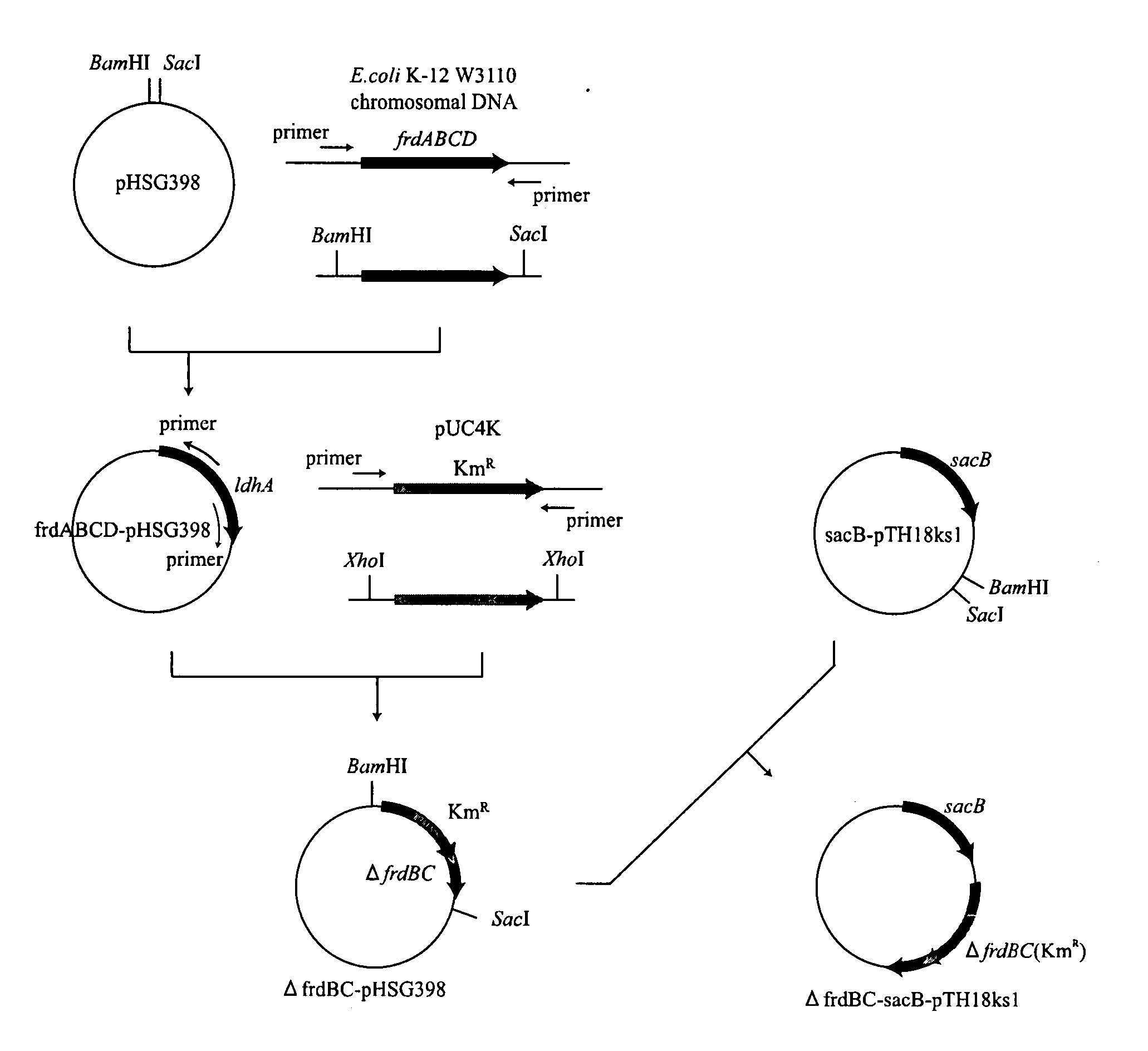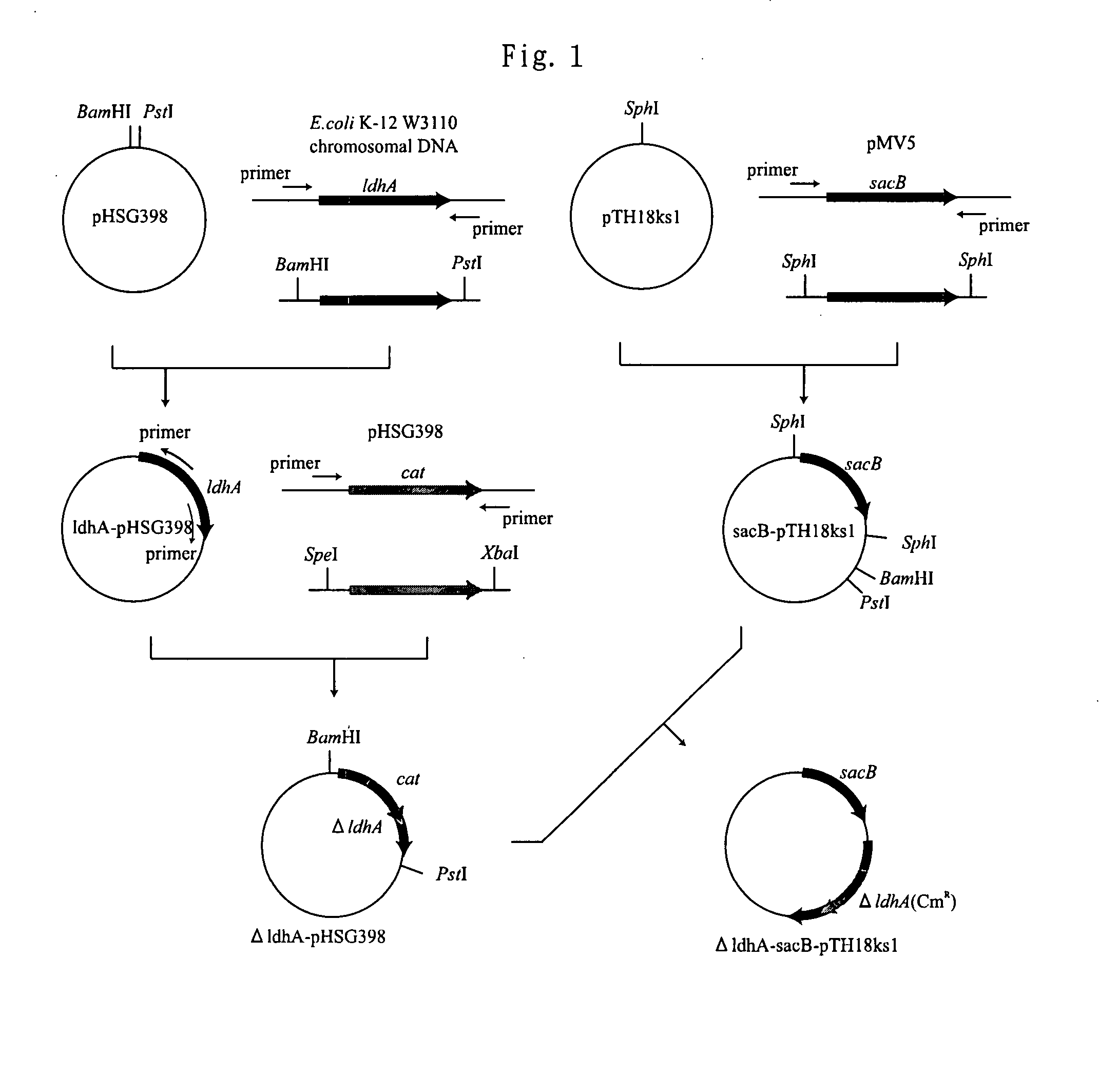Microorganism having the improved gene for hydrogen-generating capability, and process for producing hydrogen using the same
- Summary
- Abstract
- Description
- Claims
- Application Information
AI Technical Summary
Benefits of technology
Problems solved by technology
Method used
Image
Examples
example 1
[0084] Construction of the ldhA-Inactivated Strain of Escherichia coli (w3110 Strain:ATCC 27325) (Hereinafter Referred to as “ldhA-Inactivated Strain”) and a frdBC-Inactivated Strain of Said Esherichia coli (Hereinafter Referred to as “frdBC-Inactivated Strain”):
(1) Extraction of the Genome DNA
[0085] The said strain of Escherichia coli was cultured under shaking in 10 mL of the LB culture medium (Luria-Bertani culture medium) shown in Table 1 at 37° C. overnight, and the genome DNA was extracted using GenomicPrep Cells and Tissue DNA Isolation Kit (produced by Amersham Bioscience).
TABLE 1Composition of the LB culture mediumComposition ingredientsIngredient amountWater1000mlTryptone10gYeast extract5gSodium chloride5g
(2) Preparation of the Vector for Construction of the Strain Having ldhA Inactivated (Disrupted)
[0086] From the genome DNA obtained above under (1), the ldhA region was amplified with use of a thermal cycler, Gene Amp PCR System 9700 (produced by ABI), and using th...
example 2
[0103] The Process for Producing Hydrogen from Glucose with Use of the ldhA- and frdBC-Inactivated Strain as Obtained in Example 1
(1) Cultivation Under Aerobic and Anaerobic Conditions
[0104] The ldhA- and frdBC-inactivated strain as obtained in Example 1 was added to 10 mL of the culture medium having the composition shown below in Table 5 and cultured under shaking overnight at 37° C. under aerobic conditions.
[0105] 10 mL of the culture medium containing the ldhA- and frdBC-inactivated strain as cultured under shaking overnight was inoculated onto 1.0 L of the culture medium shown in Table 5, followed by culture under anaerobic conditions. Cultivation under anaerobic conditions was performed in the anaerobic chamber system (manufactured by Coy Co.) having an atmosphere of 95% nitrogen and 5% hydrogen. The culture under anaerobic conditions was conducted for 12 hours at 37° C., while maintaining the culture medium at pH 6.0 (adjusted with 5N NaOH). The resultant culture medium w...
example 3
The Process for Producing Hydrogen from Fructose with Use of the ldhA- and frdBC-Inactivated Strain as Obtained in Example 1
[0110] The initial rate of hydrogen generation and hydrogen yield were measured by the same procedure as described in Example 2 except that a 3M aqueous solution of fructose was used instead of a 3M aqueous solution of glucose for the reaction of hydrogen generation. The hydrogen yield and rate of hydrogen generation as found are shown below in Table 8.
PUM
| Property | Measurement | Unit |
|---|---|---|
| Volume | aaaaa | aaaaa |
| Molar density | aaaaa | aaaaa |
| Molar density | aaaaa | aaaaa |
Abstract
Description
Claims
Application Information
 Login to View More
Login to View More - R&D
- Intellectual Property
- Life Sciences
- Materials
- Tech Scout
- Unparalleled Data Quality
- Higher Quality Content
- 60% Fewer Hallucinations
Browse by: Latest US Patents, China's latest patents, Technical Efficacy Thesaurus, Application Domain, Technology Topic, Popular Technical Reports.
© 2025 PatSnap. All rights reserved.Legal|Privacy policy|Modern Slavery Act Transparency Statement|Sitemap|About US| Contact US: help@patsnap.com



